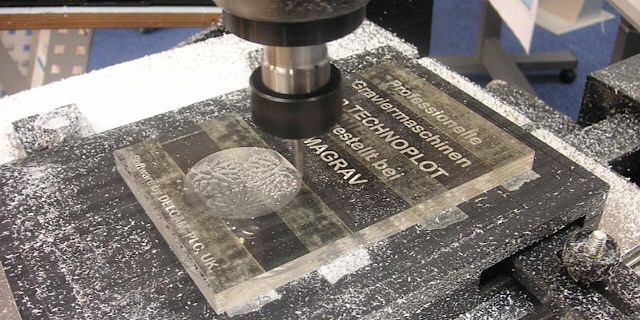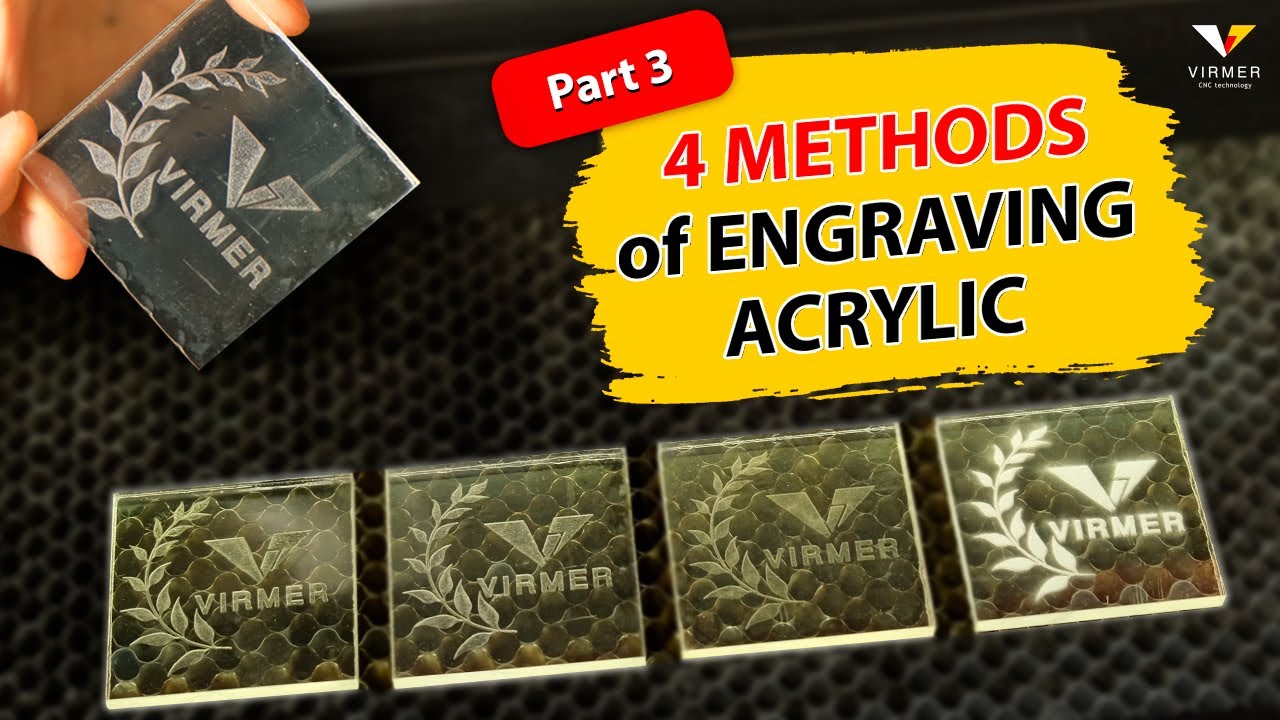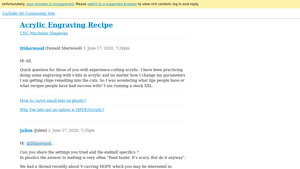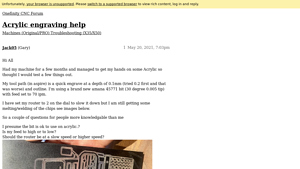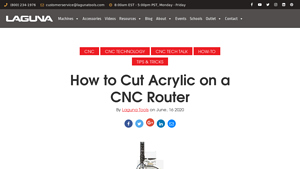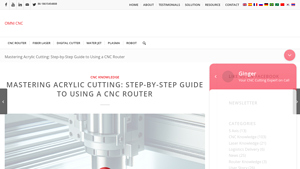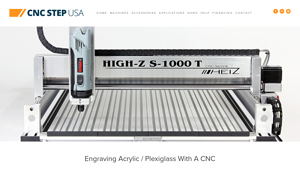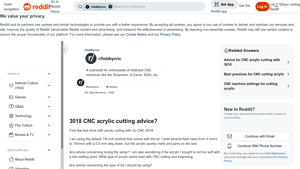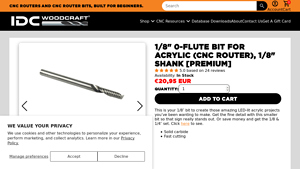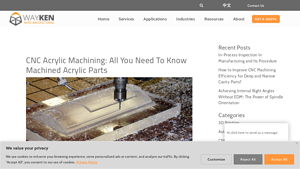Cnc Acrylic Engraving Guide: Type, Cost, Top List…
Introduction: Navigating the Global Market for cnc acrylic engraving
In today’s competitive global market, sourcing high-quality CNC acrylic engraving solutions presents a significant challenge for international B2B buyers. With a myriad of options available, from various types of acrylic materials to cutting-edge CNC machinery, making informed purchasing decisions can be overwhelming. This comprehensive guide is designed to navigate the complexities of CNC acrylic engraving, covering essential topics such as types of acrylic, applications across diverse industries, supplier vetting processes, and cost considerations.
By providing actionable insights and expert recommendations, this guide empowers businesses in Africa, South America, the Middle East, and Europe—such as those in Brazil and Germany—to optimize their sourcing strategies. Whether you are looking to create stunning promotional displays, custom signage, or intricate design elements, understanding the nuances of CNC acrylic engraving will enhance your procurement process.
With detailed information on the latest technologies, best practices for engraving, and tips for selecting reliable suppliers, this guide serves as a valuable resource for companies aiming to leverage CNC acrylic engraving for competitive advantage. Equip yourself with the knowledge necessary to make strategic decisions that align with your business goals and elevate your product offerings in the marketplace.
Understanding cnc acrylic engraving Types and Variations
| Type Name | Key Distinguishing Features | Primary B2B Applications | Brief Pros & Cons for Buyers |
|---|---|---|---|
| Flat Engraving | Engraving on flat surfaces; often used for detailed designs. | Signage, awards, decorative panels | Pros: High precision, versatile designs. Cons: Limited to flat surfaces, may require post-processing. |
| 3D Relief Engraving | Creates depth and dimensional effects; involves varying depths. | Custom art, trophies, displays | Pros: Eye-catching, adds value. Cons: More complex setup, longer machining time. |
| V-Carving | Utilizes a V-shaped bit for intricate designs and lettering. | Personalized gifts, signage | Pros: Sharp detail, excellent for text. Cons: Slower process, requires careful bit selection. |
| Cylindrical Engraving | Engraving on cylindrical objects; often requires a rotary axis. | Promotional items, custom trophies | Pros: Unique applications, enhances product offerings. Cons: More expensive machinery, complex setup. |
| LED-Backlit Engraving | Engraving designs that are illuminated from behind. | Displays, signage, art pieces | Pros: High visual impact, modern appeal. Cons: Requires additional components for lighting, more complex design considerations. |
What are the Characteristics of Flat Engraving in CNC Acrylic Engraving?
Flat engraving is characterized by its ability to produce intricate designs on flat acrylic surfaces, making it ideal for signage and decorative panels. This method allows for high precision and versatility, enabling businesses to create detailed graphics or text. However, it is important for buyers to consider that this technique is limited to flat surfaces and may require additional finishing processes to achieve the desired aesthetic quality.
How Does 3D Relief Engraving Differ from Other Techniques?
3D relief engraving involves creating depth in the design, adding a three-dimensional effect that enhances visual appeal. This method is particularly suited for custom art pieces, trophies, and displays, allowing for unique, eye-catching products. Businesses should note that while the results can be stunning, the setup is more complex, and the machining time is typically longer compared to flat engraving.
What Makes V-Carving a Popular Choice for Personalized Products?
V-carving utilizes a V-shaped bit to create detailed designs and lettering, making it a favored choice for personalized gifts and signage. The sharp detail it offers is particularly advantageous for text-heavy projects. However, buyers must be aware that this process is slower and requires careful selection of bits to ensure quality results, which can impact overall production timelines.
What are the Advantages and Challenges of Cylindrical Engraving?
Cylindrical engraving is designed for engraving on round or cylindrical objects, often necessitating the use of a rotary axis. This technique opens up unique applications for promotional items and custom trophies, allowing businesses to differentiate their offerings. However, it comes with challenges such as higher equipment costs and a more complex setup, which may not be feasible for all buyers.
How Does LED-Backlit Engraving Enhance Visual Appeal?
LED-backlit engraving involves creating designs that are illuminated from behind, resulting in striking displays and signage. This modern technique is particularly effective for attracting attention in retail and exhibition settings. While it offers high visual impact, businesses must consider the additional components required for lighting and the more complex design considerations that come with integrating illumination into their products.
Key Industrial Applications of cnc acrylic engraving
| Industry/Sector | Specific Application of CNC Acrylic Engraving | Value/Benefit for the Business | Key Sourcing Considerations for this Application |
|---|---|---|---|
| Signage | Custom sign production for retail and corporate use | Enhanced visibility and branding through high-quality signage | Quality of acrylic, precision of engraving, and turnaround time |
| Medical Equipment | Engraving labels and components for medical devices | Improved product identification and compliance with regulations | Material safety certifications and durability requirements |
| Interior Design | Decorative panels and custom furnishings | Unique aesthetic appeal that enhances interior spaces | Design customization options and material thickness |
| Automotive | Custom dashboards and interior elements | Personalization of vehicles to meet consumer preferences | Compatibility with existing vehicle designs and finishes |
| Promotional Products | Customized awards and trophies | Increased brand loyalty through personalized giveaways | Quality of engraving and ability to handle intricate designs |
How is CNC Acrylic Engraving Used in Signage Production?
CNC acrylic engraving is widely utilized in the signage industry to create custom signs for retail and corporate environments. By using high-quality acrylic, businesses can achieve vibrant colors and precise details, enhancing their visibility and brand recognition. This technology allows for the production of intricate designs and logos that are both durable and visually appealing. For international buyers, sourcing suppliers who understand local signage regulations and can provide rapid turnaround times is crucial to maintaining competitive advantage.
What Role Does CNC Acrylic Engraving Play in Medical Equipment Manufacturing?
In the medical sector, CNC acrylic engraving is essential for producing labels and components that require precise identification, such as surgical instruments and laboratory equipment. This application ensures compliance with stringent regulations regarding product identification and traceability. Buyers in this industry must prioritize suppliers who can provide materials that meet safety certifications and durability standards, particularly in regions with strict health regulations.
How Can Interior Designers Benefit from CNC Acrylic Engraving?
Interior designers leverage CNC acrylic engraving to create decorative panels and custom furnishings that add a unique aesthetic to spaces. This technique allows for the production of personalized designs that cater to specific client preferences, enhancing the overall ambiance of residential and commercial environments. Buyers should consider the customization capabilities of suppliers and the types of finishes available to ensure that the final product aligns with their design vision.
Why is CNC Acrylic Engraving Important in the Automotive Industry?
In the automotive sector, CNC acrylic engraving is used to produce custom dashboards and interior elements that enhance vehicle personalization. This application allows manufacturers to create unique designs that cater to consumer preferences, thereby increasing customer satisfaction and brand loyalty. Buyers should focus on sourcing suppliers who can ensure compatibility with existing vehicle designs while offering a variety of finishes to meet diverse aesthetic needs.
How Does CNC Acrylic Engraving Enhance Promotional Products?
CNC acrylic engraving plays a significant role in the production of customized awards and trophies, which are often used as promotional products. By personalizing these items, businesses can foster brand loyalty and recognition among their clients and employees. For international buyers, it is vital to evaluate the quality of the engraving and the supplier’s ability to handle intricate designs, ensuring that the final products effectively represent their brand image.
3 Common User Pain Points for ‘cnc acrylic engraving’ & Their Solutions
Scenario 1: Ensuring Quality Cuts Without Melting
The Problem: B2B buyers frequently encounter issues with acrylic melting during the engraving process. This problem can lead to poor-quality finishes, increased waste, and the need for additional production time to correct errors. Buyers in industries such as signage, custom displays, and artistic applications may find that using the wrong tools or settings can result in melted edges, ruining the aesthetic appeal of their products. The melting point of acrylic is relatively low, and many buyers struggle to find the right balance between speed and precision, leading to frustration.
The Solution: To prevent melting, it is crucial to select the appropriate CNC router bit and set optimal machine parameters. Use a 0-flute bit specifically designed for acrylic, as it minimizes contact with the material and reduces the risk of melting. Adjust the feed rate between 75-300 inches per minute (IPM) based on the size of the bit. For example, larger bits can handle higher speeds, while smaller ones should operate at lower speeds. It’s also recommended to run the spindle at a minimum of 18,000 RPM to maintain effective cutting without overheating the material. Implementing a mist cooling system can further enhance cutting quality by dissipating heat during the engraving process. By carefully sourcing the right tools and adjusting machine settings, buyers can achieve high-quality engravings without compromising the integrity of the acrylic.
Scenario 2: Selecting the Right Acrylic Material for Engraving
The Problem: Many B2B buyers struggle with choosing the correct type of acrylic for their engraving projects. With various acrylic options available, including extruded and cast acrylic, selecting the wrong material can lead to challenges such as uneven cuts, surface imperfections, and difficulties in achieving desired design effects. Buyers may also face confusion regarding the availability of colors and thicknesses, which could impact production timelines and project costs.
The Solution: To ensure optimal engraving results, buyers should prioritize cast acrylic over extruded acrylic for their projects. Cast acrylic offers a cleaner cut and better surface quality, which is particularly important for detailed designs and high-end applications. When selecting acrylic, consider factors such as thickness, color, and finish. For instance, clear acrylic is lightweight and shatter-resistant, making it ideal for various applications, including signage and decorative elements. Buyers should also work closely with suppliers to understand available options, including custom colors and thicknesses, and explore bulk purchasing to manage costs effectively. By making informed choices about material specifications, buyers can enhance their engraving outcomes and maintain production efficiency.
Scenario 3: Overcoming Design Limitations in CNC Acrylic Engraving
The Problem: B2B buyers often find themselves limited by the design capabilities of their CNC engraving software. Many may use basic software that lacks advanced features for 2D and 3D engraving, restricting their ability to create intricate designs or custom shapes. This limitation can hinder creativity, reduce competitiveness in the market, and lead to dissatisfaction among clients who expect high-quality, unique products.
The Solution: To expand design capabilities, buyers should invest in advanced CNC software solutions such as V-Carve Pro, which offers a range of features for 2D, 2.5D, and 3D engraving. This software includes comprehensive drawing and editing tools, allowing users to create original designs or modify existing templates easily. Additionally, the software provides various toolpath options to customize settings for different engraving styles, such as pocketing, fluting, and V-Carving. Buyers can also benefit from taking training courses or workshops to enhance their design skills and maximize the software’s potential. By leveraging advanced software and continuous learning, buyers can overcome design limitations and produce high-quality, custom acrylic engravings that meet the demands of their clients.
Strategic Material Selection Guide for cnc acrylic engraving
When selecting materials for CNC acrylic engraving, it’s crucial to consider the specific properties and performance characteristics that will impact the end product. Here, we analyze four common materials used in conjunction with CNC acrylic engraving, focusing on their key properties, advantages and disadvantages, and considerations for international B2B buyers.
What Are the Key Properties of Cast Acrylic for CNC Engraving?
Cast acrylic is a preferred choice for CNC engraving due to its excellent optical clarity and ease of machining. It has a high impact resistance and a lower melting point compared to other plastics, making it easier to work with. Cast acrylic is less prone to warping and provides a clean edge finish, which is essential for high-quality engraving.
Pros and Cons: The durability of cast acrylic is a significant advantage, as it withstands outdoor conditions without yellowing. However, it can be more expensive than extruded acrylic, which may be a consideration for budget-conscious businesses. Additionally, while cast acrylic is easier to engrave, it requires careful handling to avoid scratches during production.
How Does Extruded Acrylic Compare in CNC Applications?
Extruded acrylic is another common material, known for its lower cost and availability in larger sheets. It is generally easier to cut but can produce a gummy residue during CNC processes, which may affect the quality of the engraving.
Pros and Cons: The main advantage of extruded acrylic is its cost-effectiveness, making it suitable for larger projects or bulk orders. However, its tendency to melt and distort during cutting can lead to lower quality outputs, which may not meet the standards required for high-end applications.
What Are the Benefits of Polycarbonate in CNC Engraving?
Polycarbonate is a robust alternative to acrylic, offering superior impact resistance and thermal stability. It is often used in applications where durability is paramount, such as safety equipment and protective shields.
Pros and Cons: The key advantage of polycarbonate is its strength and resistance to shattering, making it ideal for demanding environments. However, it can be more challenging to machine and may require specialized tooling and techniques, increasing manufacturing complexity and cost.
What Should International Buyers Consider When Choosing Materials?
For international B2B buyers, particularly from regions like Africa, South America, the Middle East, and Europe, compliance with local standards such as ASTM (American Society for Testing and Materials), DIN (Deutsches Institut für Normung), or JIS (Japanese Industrial Standards) is critical. Buyers should also consider the availability of materials in their region, as shipping costs and lead times can significantly affect overall project budgets. Furthermore, preferences for specific types of acrylic, such as cast or extruded, may vary by market, influencing purchasing decisions.
Summary Table of Material Selection for CNC Acrylic Engraving
| Material | Typical Use Case for CNC Acrylic Engraving | Key Advantage | Key Disadvantage/Limitation | Relative Cost (Low/Med/High) |
|---|---|---|---|---|
| Cast Acrylic | High-quality signage and decorative items | Excellent optical clarity and durability | Higher cost compared to extruded acrylic | Medium |
| Extruded Acrylic | Budget-friendly projects and displays | Cost-effective and readily available | Gummy residue during machining | Low |
| Polycarbonate | Safety shields and high-impact applications | Superior strength and impact resistance | More complex machining requirements | High |
| Acrylic Composites | Custom parts and illuminated displays | Unique aesthetic options and versatility | Potentially higher production costs | Medium |
This strategic material selection guide provides a comprehensive overview for B2B buyers looking to optimize their CNC acrylic engraving projects, ensuring they make informed decisions that align with their operational needs and market standards.
In-depth Look: Manufacturing Processes and Quality Assurance for cnc acrylic engraving
What Are the Key Stages in the Manufacturing Process of CNC Acrylic Engraving?
CNC acrylic engraving is a meticulous process that involves several key stages, ensuring the final product meets the high standards expected by B2B buyers. Understanding these stages is crucial for evaluating suppliers and ensuring product quality.
1. Material Preparation: How Is Acrylic Selected and Processed?
The first step in the manufacturing process is selecting the right type of acrylic. For optimal results, cast acrylic is often preferred over extruded acrylic due to its superior cutting properties, resulting in cleaner edges and less melting. After selecting the material, it is cut into manageable sizes that fit the CNC machine’s specifications.
Once cut, the acrylic sheets undergo a thorough cleaning to remove any contaminants that could affect the engraving quality. This step is particularly important as impurities can lead to defects during the engraving process.
2. Forming: What Techniques Are Used in CNC Engraving?
The forming stage involves using a CNC router or laser to engrave the acrylic. This is where precision is paramount. Key techniques include:
-
CNC Routing: Utilizing specialized bits, such as O-flute bits for cutting and V-bits for engraving, ensures clean cuts and high-quality engravings. The choice of bit and the machine settings, such as feed rate and spindle speed, significantly influence the outcome.
-
Laser Engraving: For intricate designs, laser engraving may be employed. This method allows for detailed patterns but requires careful temperature control to prevent melting.
During this stage, operators must monitor the machine’s performance continuously to ensure accuracy and quality.
3. Assembly: How Are Engraved Pieces Put Together?
For products requiring assembly, the engraved acrylic pieces are carefully fitted together. This may involve adhesive bonding or mechanical fastening, depending on the design. Quality assurance during this phase ensures that all components fit correctly and function as intended.
4. Finishing: What Steps Are Taken to Enhance the Final Product?
The finishing stage is where the product truly comes to life. This can include polishing edges to remove any burrs, applying protective coatings, or adding color treatments to enhance aesthetics. Quality checks at this stage focus on visual inspection and tactile assessment to ensure the product meets the required standards.
What Quality Assurance Standards Are Relevant for CNC Acrylic Engraving?
Quality assurance in CNC acrylic engraving is governed by both international and industry-specific standards. Understanding these can help B2B buyers ensure they are sourcing from reputable suppliers.
ISO 9001: What Does This Standard Mean for Manufacturers?
ISO 9001 is a widely recognized quality management standard that outlines the requirements for a quality management system (QMS). Suppliers adhering to this standard demonstrate their commitment to providing quality products and services. B2B buyers should request certification documents to verify compliance.
CE Marking: Why Is It Important for Acrylic Products in Europe?
CE marking indicates that a product meets EU safety, health, and environmental protection standards. For buyers in Europe, sourcing from suppliers with CE certification is crucial to ensure compliance with local regulations.
API Standards: Are There Specific Requirements for Certain Industries?
In industries such as oil and gas, API (American Petroleum Institute) standards may apply. While not directly related to acrylic engraving, suppliers serving these industries may be required to meet these additional standards, adding another layer of quality assurance.
What Are the Key Quality Control Checkpoints in CNC Acrylic Engraving?
Quality control is integral to the CNC acrylic engraving process, with several checkpoints established to ensure product integrity.
Incoming Quality Control (IQC): How Is Material Quality Assessed?
IQC is the first checkpoint, where incoming raw materials are inspected for quality. This includes checking for defects in the acrylic sheets and verifying that they meet the required specifications before they are used in production.
In-Process Quality Control (IPQC): What Monitoring Is Done During Production?
During production, IPQC involves ongoing monitoring of the engraving process. Operators check machine settings, monitor cutting speeds, and assess the quality of the engravings at various stages. This proactive approach helps catch any issues before they escalate.
Final Quality Control (FQC): How Are Finished Products Evaluated?
FQC is conducted after the engraving and finishing processes. This includes visual inspections and functional tests to ensure the final products meet the specified criteria. Documentation of this process is crucial for traceability.
How Can B2B Buyers Verify Supplier Quality Control Practices?
For international B2B buyers, verifying a supplier’s quality control practices is essential. Here are several strategies to consider:
Supplier Audits: What Should Buyers Look For?
Conducting supplier audits allows buyers to assess the manufacturing processes and quality control systems in place. During these audits, buyers should look for compliance with international standards, documentation of quality checks, and evidence of continuous improvement efforts.
Quality Reports: How Do These Documents Help?
Requesting quality reports from suppliers can provide insight into their QC practices. These reports should detail inspection results, any issues encountered during production, and how they were addressed.
Third-Party Inspections: Why Are They Beneficial?
Engaging third-party inspection services can add an extra layer of assurance. These independent entities can provide objective evaluations of a supplier’s quality control processes and product quality, helping buyers make informed decisions.
What Are the Nuances of Quality Control for International B2B Buyers?
B2B buyers from regions such as Africa, South America, the Middle East, and Europe may encounter unique challenges in verifying quality control. Factors such as varying standards, regulatory compliance, and logistical considerations can complicate the sourcing process.
Understanding Regional Standards: How Do They Impact Sourcing?
Buyers should familiarize themselves with local regulations and standards that may differ from international norms. This understanding can help navigate the complexities of sourcing from different regions and ensure compliance.
Effective Communication: How Can It Enhance Quality Assurance?
Establishing clear communication channels with suppliers can facilitate better understanding of quality expectations and requirements. Regular updates and feedback can help address potential issues before they become significant problems.
Conclusion: How Can B2B Buyers Ensure Quality in CNC Acrylic Engraving?
By understanding the manufacturing processes and quality assurance practices associated with CNC acrylic engraving, B2B buyers can make more informed decisions. Prioritizing suppliers who adhere to international standards, conducting thorough audits, and verifying quality control measures can help ensure the quality and reliability of the products sourced. This diligence not only enhances the buyer’s reputation but also contributes to the overall success of their business in competitive markets.
Practical Sourcing Guide: A Step-by-Step Checklist for ‘cnc acrylic engraving’
In the competitive landscape of CNC acrylic engraving, having a structured approach to sourcing equipment and services is essential for success. This guide outlines key steps for B2B buyers to ensure they procure the best solutions tailored to their specific needs.
Step 1: Define Your Technical Specifications
Before initiating the procurement process, clearly outline your technical requirements. Consider factors such as the type of acrylic you plan to work with—cast acrylic is generally preferred for cleaner cuts—and the desired thickness. Understanding these specifications will help you filter potential suppliers effectively and ensure compatibility with your existing machinery.
Step 2: Research and Identify Reliable Suppliers
Conduct thorough research to identify reputable suppliers specializing in CNC acrylic engraving. Look for companies with a proven track record in your target market, particularly those familiar with the specific needs of businesses in Africa, South America, the Middle East, and Europe. Utilize platforms like industry directories, trade shows, and online reviews to gather insights into supplier reliability and customer satisfaction.
Step 3: Evaluate Potential Suppliers
Before committing, it’s crucial to vet suppliers thoroughly. Request company profiles, case studies, and references from buyers in a similar industry or region. Assess their experience with CNC machines and acrylic materials, as this will indicate their ability to meet your engraving requirements effectively.
- Check for Certifications: Ensure suppliers have relevant certifications, such as ISO standards, which indicate adherence to quality and safety protocols.
- Request Sample Work: Ask for examples of previous projects to evaluate the quality and precision of their CNC engraving work.
Step 4: Assess Equipment and Technology
Investigate the types of CNC routers and engraving tools the suppliers use. The choice of machinery can significantly impact the quality of the final product. Look for:
- Specifications of Machines: Ensure the machines can handle the size and thickness of acrylic you plan to use.
- Advanced Features: Consider suppliers that offer machines with high RPM settings and efficient cooling systems to prevent melting during the engraving process.
Step 5: Review Software Compatibility
Ensure that the engraving equipment is compatible with advanced design software like V-Carve Pro or similar. This compatibility is crucial for creating intricate designs and customizing projects effectively.
- Training and Support: Inquire if the supplier offers training on the software, as this can enhance your team’s efficiency and reduce the learning curve.
Step 6: Negotiate Terms and Conditions
Once you have narrowed down your options, engage in discussions regarding pricing, payment terms, and warranty policies. Ensure that the terms are favorable and offer flexibility, especially considering potential fluctuations in demand.
- Consider Long-term Partnerships: Evaluate the possibility of establishing a long-term relationship with suppliers, which can lead to better pricing and support over time.
Step 7: Finalize the Purchase and Implement
After selecting your supplier, finalize the purchase and plan for implementation. Ensure that you have a clear timeline for delivery and installation, as well as a strategy for integrating the new equipment into your operations.
Following this checklist will help streamline your sourcing process and ensure that you secure the best solutions for your CNC acrylic engraving needs.
Comprehensive Cost and Pricing Analysis for cnc acrylic engraving Sourcing
What Are the Key Cost Components in CNC Acrylic Engraving?
When sourcing CNC acrylic engraving services, understanding the cost structure is crucial for effective budgeting and negotiation. The primary cost components include:
-
Materials: The choice of acrylic significantly impacts costs. Cast acrylic, preferred for its clean cutting and aesthetic appeal, is typically more expensive than extruded acrylic. The thickness and color of the acrylic also influence pricing, as specialty colors or thicker sheets may come at a premium.
-
Labor: Skilled labor is essential for operating CNC machines and ensuring high-quality engraving. Labor costs vary by region, with skilled operators in Europe and North America generally commanding higher wages than those in Africa or South America.
-
Manufacturing Overhead: This includes expenses related to machine maintenance, utilities, and facility costs. Overhead costs can vary widely depending on the supplier’s location and operational efficiency.
-
Tooling: The selection of CNC bits and tools, which are critical for achieving desired engraving quality, also adds to the cost. High-quality, specialized bits (like O-flute bits for acrylic) may have higher upfront costs but can improve efficiency and finish quality, ultimately affecting the total cost.
-
Quality Control (QC): Implementing robust QC measures to ensure product consistency and quality adds to operational costs. Suppliers with certifications (like ISO 9001) may charge more, but this often translates into higher reliability and better end products.
-
Logistics: Shipping and handling costs can vary significantly based on the destination and the chosen Incoterms. International shipping may involve tariffs and customs duties, which should be factored into the total cost.
-
Margin: Suppliers will add a markup to cover their business expenses and desired profit. Understanding the typical margins in the industry can aid in evaluating supplier pricing.
How Do Price Influencers Affect CNC Acrylic Engraving Costs?
Several factors can influence the pricing of CNC acrylic engraving services:
-
Volume/MOQ: Higher order quantities (MOQs) often lead to lower per-unit costs due to economies of scale. Suppliers may offer discounts for bulk orders, which can significantly reduce overall expenses.
-
Specifications/Customization: Custom designs and specific dimensions can increase costs. Clear communication of requirements upfront can help in obtaining accurate quotes and avoid unexpected charges later.
-
Quality and Certifications: Suppliers with higher quality standards and relevant certifications may charge a premium. However, investing in quality can reduce the risk of defects and the associated costs of rework or returns.
-
Supplier Factors: The location, reputation, and reliability of suppliers will influence pricing. Established suppliers may offer better quality assurance but at higher costs.
-
Incoterms: The choice of Incoterms affects shipping responsibilities and costs. For example, choosing DDP (Delivered Duty Paid) means the supplier bears all shipping costs and risks, which may be reflected in higher prices.
What Are the Best Buyer Tips for Sourcing CNC Acrylic Engraving?
To maximize cost-efficiency when sourcing CNC acrylic engraving, consider the following tips:
-
Negotiate: Don’t hesitate to negotiate pricing, especially for larger orders. Suppliers may have flexibility on prices, particularly if they see a potential for long-term business.
-
Evaluate Total Cost of Ownership (TCO): Beyond initial costs, assess the long-term value of products. Consider factors such as durability, maintenance, and the potential for reusability in your calculations.
-
Understand Pricing Nuances for International Sourcing: International buyers should be aware of additional costs such as import duties, taxes, and currency fluctuations. These can significantly impact the overall expenditure, making it crucial to factor them into your budget.
-
Research Local Suppliers: For buyers in regions like Africa or South America, local suppliers might offer competitive pricing and reduced shipping costs. Investigate regional suppliers to explore potential savings.
-
Request Multiple Quotes: Gathering quotes from several suppliers can provide a clearer picture of the market rate and help identify the best value for your specific needs.
Disclaimer on Indicative Prices
Prices for CNC acrylic engraving can vary widely based on the factors outlined above. It is essential for buyers to conduct thorough research and obtain tailored quotes to understand their specific cost implications fully.
Alternatives Analysis: Comparing cnc acrylic engraving With Other Solutions
Introduction to Alternative Solutions for Acrylic Engraving
In the realm of acrylic engraving, CNC technology is a popular choice due to its precision and versatility. However, several alternative methods also exist, each with distinct advantages and drawbacks. Understanding these alternatives helps B2B buyers make informed decisions based on their unique requirements, such as budget constraints, production volume, and desired engraving quality.
Comparison Table
| Comparison Aspect | Cnc Acrylic Engraving | Laser Engraving | Manual Engraving |
|---|---|---|---|
| Performance | High precision and speed | Excellent detail, slower than CNC | Varies greatly, generally slower |
| Cost | Moderate to high initial investment | Higher initial cost for laser equipment | Low initial cost, labor-intensive |
| Ease of Implementation | Requires skilled operators and programming | User-friendly software, less training needed | Requires significant skill and experience |
| Maintenance | Regular maintenance of CNC machinery | Minimal maintenance, mainly lens cleaning | Low maintenance, but skill-dependent |
| Best Use Case | High-volume production, complex designs | Detailed artwork, one-off projects | Custom, artisanal work, small batches |
Detailed Breakdown of Alternatives
What Are the Advantages and Disadvantages of Laser Engraving?
Laser engraving utilizes focused laser beams to create intricate designs on acrylic surfaces. One of its primary advantages is the exceptional detail it can achieve, making it ideal for projects requiring fine artwork or text. Additionally, laser systems typically have user-friendly software, reducing the learning curve for operators. However, laser engraving can be slower than CNC methods, which may hinder productivity in high-volume scenarios. The initial investment for laser equipment is also generally higher, making it less feasible for smaller businesses with limited budgets.
How Does Manual Engraving Compare to CNC Engraving?
Manual engraving involves using hand-held tools to carve designs into acrylic. This method offers a high degree of artistic expression, allowing artisans to create unique, one-of-a-kind pieces. It is also a cost-effective solution since it requires minimal equipment investment. However, the performance of manual engraving is highly dependent on the skill and experience of the operator. Moreover, it is considerably slower than both CNC and laser engraving, which can limit production capacity. This method is best suited for custom, small-batch work where craftsmanship is valued over speed.
Conclusion: Choosing the Right Solution for Your Needs
When selecting an engraving method for acrylic, B2B buyers must weigh several factors, including production volume, detail requirements, and budget constraints. CNC acrylic engraving is optimal for high-volume production with complex designs, while laser engraving excels in detailed artwork but may not keep pace with mass production needs. Manual engraving is perfect for artisanal, custom projects but lacks the efficiency of automated methods. By aligning the engraving solution with their specific operational needs, buyers can enhance their production capabilities and improve their bottom line.
Essential Technical Properties and Trade Terminology for cnc acrylic engraving
What Are the Key Technical Properties for CNC Acrylic Engraving?
Understanding the critical technical properties of CNC acrylic engraving is essential for B2B buyers aiming to select the right materials and processes for their projects. Here are some key specifications to consider:
1. Material Grade
Material grade refers to the quality and type of acrylic used, such as cast or extruded acrylic. Cast acrylic is generally preferred for CNC engraving because it offers cleaner cuts and better surface finishes, while extruded acrylic tends to be more prone to melting and chipping. Selecting the right material grade impacts not only the aesthetic quality of the final product but also the durability and functionality, which are crucial for applications such as signage and decorative items.
2. Tolerance
Tolerance defines the allowable deviation in dimensions during the engraving process. For CNC acrylic engraving, typical tolerances range from ±0.1 mm to ±0.5 mm, depending on the complexity and purpose of the design. Accurate tolerances ensure that components fit together as intended, minimizing waste and reducing the need for costly rework. This is particularly important for industries that require precision, such as automotive and aerospace.
3. Feed Rate
Feed rate is the speed at which the CNC machine moves the cutting tool through the acrylic material, typically measured in inches per minute (IPM). An optimal feed rate prevents overheating and melting of the acrylic, which can compromise the quality of the engraving. For acrylic, feed rates can vary from 75 to 300 IPM, depending on the bit size and type of engraving. Understanding feed rates is critical for achieving high-quality finishes while maximizing production efficiency.
4. Spindle Speed
Spindle speed, measured in revolutions per minute (RPM), is another vital parameter in CNC engraving. A higher spindle speed—ideally around 18,000 RPM for acrylic—ensures a clean cut without melting the material. Selecting the appropriate spindle speed can greatly affect the quality of the engraving and the lifespan of the cutting tools, which is essential for maintaining cost-effectiveness.
5. Cutting Depth
Cutting depth refers to the thickness of acrylic that is removed in a single pass of the CNC bit. A recommended cutting depth is generally around half the diameter of the bit being used. Proper cutting depth is crucial for preventing tool breakage and achieving consistent engraving quality. It also impacts production speed and material usage, making it an important consideration for manufacturers.
What Are Common Trade Terms Used in CNC Acrylic Engraving?
Familiarizing yourself with industry terminology is vital for effective communication and negotiation in B2B transactions. Here are several essential terms:
1. OEM (Original Equipment Manufacturer)
OEM refers to a company that produces parts or equipment that may be marketed by another manufacturer. In the context of CNC acrylic engraving, an OEM might supply cutting tools or CNC machines specifically designed for engraving acrylic. Understanding OEM relationships can help businesses identify reliable suppliers and ensure quality materials.
2. MOQ (Minimum Order Quantity)
MOQ is the smallest quantity of a product that a supplier is willing to sell. For CNC acrylic engraving, MOQs can affect inventory management and cash flow. Buyers should negotiate MOQs to align with their production needs while considering potential cost savings with bulk purchases.
3. RFQ (Request for Quotation)
An RFQ is a document used to invite suppliers to bid on specific products or services. When seeking CNC acrylic engraving services, an RFQ allows buyers to outline their needs, such as material specifications, tolerances, and quantities, enabling suppliers to provide tailored quotes. This process helps ensure competitive pricing and clarity in project requirements.
4. Incoterms (International Commercial Terms)
Incoterms are a set of international rules that define the responsibilities of buyers and sellers in international trade, including shipping, insurance, and tariffs. Understanding Incoterms is essential for B2B transactions involving CNC acrylic engraving, as they clarify who is responsible for costs and risks at each stage of the shipping process.
5. CAD (Computer-Aided Design)
CAD refers to the use of software to create precise drawings and technical illustrations for CNC engraving. Familiarity with CAD tools is crucial for ensuring that designs meet the required specifications and can be efficiently translated into the CNC machine’s programming. This knowledge is vital for minimizing errors and streamlining the production process.
By grasping these technical properties and trade terms, B2B buyers can make informed decisions that enhance their CNC acrylic engraving projects, ensuring quality and efficiency in their operations.
Navigating Market Dynamics and Sourcing Trends in the cnc acrylic engraving Sector
What are the Current Market Dynamics and Key Trends in the CNC Acrylic Engraving Sector?
The CNC acrylic engraving market is witnessing significant growth driven by various global trends. The increasing demand for personalized products across industries such as signage, retail, and interior design is a primary driver. Businesses are increasingly leveraging CNC technology for its precision and ability to handle intricate designs, making it ideal for custom engraving applications. Moreover, the rise of e-commerce platforms facilitates international transactions, providing B2B buyers from regions like Africa, South America, the Middle East, and Europe greater access to diverse suppliers and innovative solutions.
Emerging technologies such as advanced CAD/CAM software and machine learning are transforming the landscape of CNC engraving. These tools allow businesses to streamline their design processes, enhance productivity, and reduce lead times. The integration of automation in CNC machines is another trend that is reshaping production capabilities, offering higher efficiency and lower operational costs. As companies seek to optimize their manufacturing processes, the demand for multi-functional CNC machines that can handle a variety of materials, including acrylic, is on the rise.
Furthermore, sustainability is becoming a focal point for buyers, with an increasing preference for suppliers who prioritize eco-friendly practices and materials. This shift is not only a response to consumer demand but also aligns with regulatory requirements in many regions, particularly in Europe. As a result, B2B buyers must navigate a landscape where technological advancements and sustainable practices coexist, ensuring they partner with suppliers who can meet these evolving expectations.
How is Sustainability Influencing Sourcing Decisions in the CNC Acrylic Engraving Market?
Sustainability is a critical consideration for B2B buyers in the CNC acrylic engraving sector. The environmental impact of manufacturing processes, including the production and disposal of acrylic materials, is garnering attention. Acrylic, while versatile, can contribute to pollution if not sourced and processed responsibly. Therefore, businesses are increasingly looking for suppliers that demonstrate a commitment to sustainable practices, such as using recycled acrylic or minimizing waste in their operations.
Ethical sourcing is also gaining traction as companies recognize the importance of transparency in their supply chains. Buyers are prioritizing partnerships with manufacturers that adhere to ethical labor practices and have certifications demonstrating their commitment to sustainability. Certifications such as ISO 14001 (Environmental Management) and FSC (Forest Stewardship Council) can serve as indicators of a supplier’s dedication to minimizing their environmental footprint.
Moreover, the trend toward green materials is influencing product offerings in the CNC acrylic engraving market. Suppliers are exploring biodegradable alternatives and developing acrylic products with lower environmental impact. By prioritizing sustainability, B2B buyers can not only enhance their brand reputation but also meet the growing consumer demand for environmentally responsible products.
How Has the CNC Acrylic Engraving Sector Evolved Over Time?
The evolution of CNC acrylic engraving can be traced back to the advent of computer-aided design (CAD) and computer numerical control (CNC) technology in the late 20th century. Initially used primarily in industrial applications, these technologies have become more accessible to small and medium-sized enterprises (SMEs), allowing for widespread adoption across various sectors.
As the technology matured, the introduction of advanced CNC machines with enhanced capabilities, such as higher precision and the ability to work with a wider range of materials, further propelled the market. The development of specialized CNC bits designed for acrylic engraving has also contributed to improved efficiency and quality in production processes.
Today, CNC acrylic engraving stands at the intersection of technology and creativity, enabling businesses to produce intricate designs and personalized products with relative ease. This evolution not only reflects advancements in technology but also the changing demands of consumers and industries alike, highlighting the importance of innovation in the B2B landscape.
Frequently Asked Questions (FAQs) for B2B Buyers of cnc acrylic engraving
-
How do I choose the right CNC machine for acrylic engraving?
Selecting the right CNC machine involves assessing your specific needs, including the size and complexity of the projects you’ll undertake. Look for machines with high RPM capabilities (at least 18,000 RPM) and the ability to handle various bit types. A router with a vacuum table is advantageous for securing acrylic sheets. Additionally, consider machines with user-friendly software for design and operation, ensuring you can easily create intricate designs and manage production efficiently. -
What type of bit is best for CNC acrylic engraving?
For engraving acrylic, a 60° engraving bit or a 1/4-inch solid carbide O-flute bit is recommended. The O-flute bit minimizes chip buildup and provides cleaner cuts, while the engraving bit allows for fine details and sharp edges. Always opt for high-quality carbide bits to enhance tool longevity and performance. This choice directly affects the quality of your final product, so investing in the right bit is crucial for achieving professional results. -
What are the common customization options for CNC acrylic engraving?
Customization options for CNC acrylic engraving can include various shapes, sizes, colors, and finishes. Suppliers often offer the ability to engrave logos, text, and intricate designs tailored to your specifications. Ensure to communicate your requirements clearly during the initial stages to avoid misunderstandings. Additionally, inquire about the supplier’s capabilities to handle custom orders and their willingness to accommodate unique requests or prototypes. -
What are the minimum order quantities (MOQs) for CNC acrylic engraving?
Minimum order quantities can vary significantly by supplier and project complexity. Many suppliers may have MOQs ranging from 50 to 100 units for mass production, but they might be flexible for custom or prototype orders. It’s essential to discuss MOQs upfront when sourcing suppliers to ensure they align with your business needs and budget. Smaller quantities may incur higher per-unit costs, so consider your production scale and budget when negotiating. -
What payment terms should I expect when sourcing CNC acrylic engraving services?
Payment terms can vary based on the supplier’s policies and your relationship with them. Common arrangements include a deposit (often 30-50%) upfront, with the balance due upon completion or delivery. It’s advisable to negotiate terms that suit your cash flow needs, especially for larger orders. Always clarify payment methods accepted, such as bank transfers, letters of credit, or digital payment platforms, to ensure smooth transactions. -
How can I ensure quality assurance for CNC acrylic engraving products?
To ensure quality assurance, request samples before placing large orders. Evaluate the engraving quality, finish, and adherence to your specifications. Additionally, inquire about the supplier’s quality control processes, such as inspections and certifications. Establishing clear communication regarding your quality expectations and feedback mechanisms is crucial. Regular audits and checks during production can also help maintain quality standards throughout the process. -
What logistics considerations should I keep in mind when sourcing CNC acrylic engraving?
Logistics play a critical role in sourcing CNC acrylic engraving services. Consider shipping costs, delivery times, and the supplier’s ability to handle international shipping. Ensure that the supplier can provide proper packaging to prevent damage during transit. Additionally, familiarize yourself with customs regulations and import duties in your country to avoid unexpected costs. Collaborating with a logistics provider can streamline the process and ensure timely delivery. -
How do I vet suppliers for CNC acrylic engraving services?
Vetting suppliers involves researching their credentials, experience, and customer reviews. Look for suppliers with a proven track record in CNC acrylic engraving and relevant industry certifications. Request references from previous clients to gauge their reliability and quality of work. Additionally, consider visiting their facilities if possible, to observe their processes and capabilities firsthand. Establishing a solid relationship with a trustworthy supplier can significantly enhance your project’s success.
Important Disclaimer & Terms of Use
⚠️ Important Disclaimer
The information provided in this guide, including content regarding manufacturers, technical specifications, and market analysis, is for informational and educational purposes only. It does not constitute professional procurement advice, financial advice, or legal advice.
While we have made every effort to ensure the accuracy and timeliness of the information, we are not responsible for any errors, omissions, or outdated information. Market conditions, company details, and technical standards are subject to change.
B2B buyers must conduct their own independent and thorough due diligence before making any purchasing decisions. This includes contacting suppliers directly, verifying certifications, requesting samples, and seeking professional consultation. The risk of relying on any information in this guide is borne solely by the reader.
Top 8 Cnc Acrylic Engraving Manufacturers & Suppliers List
1. Carbide 3D – Acrylic Engraving Recipe for CNC Machines
Domain: community.carbide3d.com
Registered: 2013 (12 years)
Introduction: Acrylic Engraving Recipe for CNC Machines, specifically for Shapeoko. Key settings include: 10,000 RPM spindle speed, feed rates of 40-80 IPM, plunge rates of 20-60 IPM, and a depth of cut (DOC) of 0.005″ to 0.02″ per pass. Recommended tools include a 90-degree V-bit and a high-quality single flute cutter. Emphasis on using cast acrylic over extruded acrylic for better machining results. Importanc…
2. Onefinity CNC – Acrylic Material Guide
Domain: forum.onefinitycnc.com
Registered: 2020 (5 years)
Introduction: This company, Onefinity CNC – Acrylic Material Guide, is a notable entity in the market. For specific product details, it is recommended to visit their website directly.
3. Laguna Tools – Swift MT CNC Router
Domain: info.lagunatools.com
Registered: 1996 (29 years)
Introduction: Product Name: Swift MT CNC Router
Key Features:
– Multi-tool functionality for cutting, routing, and creasing
– Suitable for a wide range of materials including acrylic, wood, cardboard, rubber, foam, leather, carpet, gaskets, and aluminum
– 4- to 6-zone phenolic vacuum table for material security
– Tangential knife system and multi-tool head
– 7-inch gantry clearance
– Helical rack and pinion on…
4. Omni – 5-Axis CNC Router Machines
Domain: omni-cnc.com
Registered: 2009 (16 years)
Introduction: Omni 5-Axis CNC Router Machines provide exceptional precision and reliability in woodworking, plastic & foam cutting, making them ideal for complex projects. The guide emphasizes the importance of understanding acrylic properties, selecting suitable tools, and optimizing machine setup for precise and clean cuts. It highlights the advantages of CNC routers, including versatility, precision, cost-ef…
5. CNC Step USA – High-Z & T-Rex CNC Machines
Domain: cncstepusa.com
Registered: 2011 (14 years)
Introduction: Engrave acrylic and plexiglass with High-Z or T-Rex CNC machines. For cylindrical objects, the 4th axis RounDino 120 is recommended. Acrylic has a low melting point of around 80 degrees Celsius (175 Fahrenheit), so a minimal lubrication system (mist cooling unit) is advised to prevent melting, improve edge quality, and extend tool life. Applications include producing custom parts for medical labs …
6. CNC Solutions – Acrylic Cutting Recommendations
Domain: reddit.com
Registered: 2005 (20 years)
Introduction: 3018 CNC machine; 1/8 inch endmill; feed rates from 4 mm/s to 10 mm/s; 0.5 mm step down; types of acrylic: extruded and cast; recommendations for cutting: faster feed rate, single flute endmill, cooling methods (vacuum or water pools), RPM settings (6000 to 17000), and cutting speeds (2500 mm/min).
7. IDC Woodcraft – 1/8 0-Flute Bit For Acrylic
Domain: idcwoodcraft.com
Registered: 2020 (5 years)
Introduction: {“name”: “1/8\” 0-Flute Bit For Acrylic (CNC Router)”, “shank_size”: “1/8\””, “type”: “Premium”, “price”: “£19.00 GBP”, “availability”: “In Stock”, “material”: “Solid carbide”, “features”: [“Fast cutting”, “Enhance Your Carve”, “Designed for acrylic projects”], “specifications”: {“diameter”: “1/8\””, “flute_type”: “0-flute”}, “sku”: “OF-18”, “customer_reviews”: {“total_reviews”: 24, “positive_revi…
8. WayKen – CNC Acrylic Machining
Domain: waykenrm.com
Registered: 2013 (12 years)
Introduction: CNC Acrylic Machining involves the automated process of cutting and shaping acrylic (PMMA) using specialized tools. Key benefits include precision, the ability to create complex geometries, flexibility for various project requirements, fine surface finishes, and increased production rates. Acrylic is lightweight, UV resistant, durable (tensile strength up to 10,000 PSI), transparent (light transmi…
Strategic Sourcing Conclusion and Outlook for cnc acrylic engraving
In conclusion, the strategic sourcing of CNC acrylic engraving solutions offers significant advantages for international B2B buyers. By selecting high-quality materials, such as cast acrylic, and employing the right CNC machinery and tooling, businesses can achieve superior precision and efficiency in their projects. It is crucial to consider factors like feed rates, spindle speeds, and appropriate bit selection to optimize the engraving process and avoid issues such as melting or chipping.
Investing in advanced CNC technology not only enhances product quality but also opens up new avenues for creative applications, from customized signage to intricate 3D designs. As the demand for personalized and innovative acrylic products grows globally, companies that prioritize strategic sourcing will be well-positioned to capitalize on emerging market opportunities, particularly in regions like Africa, South America, the Middle East, and Europe.
Looking ahead, now is the time for international B2B buyers to explore partnerships with reliable suppliers and manufacturers that can deliver cutting-edge CNC solutions. Embrace the potential of CNC acrylic engraving to elevate your product offerings and drive business growth in an increasingly competitive landscape.
